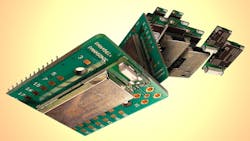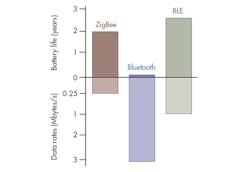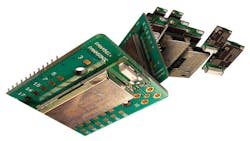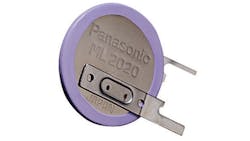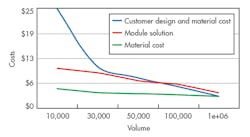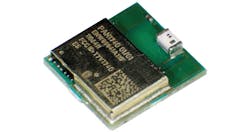Moving Bluetooth Low Energy Closer to the Mainstream
Bluetooth Low Energy (BLE) may not be part of your electronic designs just yet, but chances are it will be soon. This wireless connectivity technology has experienced explosive growth over the last three years. It now provides low-power connectivity to millions of electronic devices, such as smart watches, fitness trackers, smartphone accessories, and medical monitors. Thanks to upcoming technical enhancements, BLE is poised to become even more pervasive in the next generation of consumer electronics and the emerging Internet of Things (IoT).
Many of these improvements have been incorporated in Bluetooth 4.1, a recent update to the core specification. These updates include support for more efficient bulk data transfers, greater flexibility in communications between devices, simultaneous dual-mode roles, and the first steps toward IP-based communications. Taken together, these technical improvements make BLE even more attractive from power consumption, performance, and cost standpoints (Fig. 1).
In addition to the changes outlined in Bluetooth 4.1, the BLE chips themselves have been continuously improving as well. Thanks to efficiency improvements, transmission power consumption in the second generation of BLE will fall by about 66% with no loss of range or performance.
BLE isn’t the only game in town when it comes to low-power wireless communications, though. ANT and ZigBee have capabilities that overlap with BLE, and both wireless standards have their place (Fig. 2). However, BLE does have significant advantages when you consider its technical capabilities and the fact that it is an open protocol.
This file type includes high resolution graphics and schematics when applicable.
BLE Basics
For wireless communication devices that have been optimized for low power consumption rather than maximum data transfer rates, BLE fits the bill perfectly. It consumes as little as one-hundredth the average power required by Bluetooth Classic. Also, BLE’s peak current draw is as low as 15 mA, compared to 40 mA or more for Bluetooth Classic. With such thrifty current consumption, BLE can run on a single coin-cell battery for months or even years, depending on the application (Fig. 3).
BLE achieves its low power consumption primarily by keeping its radio turned off most of the time. BLE scans only three advertising channels; its radio awakens only to send or receive short bursts of data, with small packet sizes from 8 to 27 octets. BLE also sets up connections very quickly, which further minimizes the radio’s on time. BLE can transmit authenticated data in as little as 3 ms, versus the 1000 ms typical for Bluetooth Classic.
Furthermore, BLE’s maximum practical data rate is typically well under 100 kbits/s. So, it’s not intended for the continuous data streaming applications possible with Bluetooth Classic, which offers data rates up to 3 Mbits/s.
BLE’s technology differs from Bluetooth Classic’s in other ways. Chief among them, BLE uses a star network topology and 32-bit access address on every packet for each slave, which theoretically allows billions of devices to be connected at a given time. Bluetooth Classic’s piconet topology, by contrast, allows only up to eight devices at a time.
Other BLE technical features include:
- Optimized Gaussian frequency shift keying (GFSK) modulation. Like Bluetooth Classic, BLE uses a GFSK modulation scheme. BLE, however, uses a higher modulation index and 2-MHz channels for lower bit error rates that translate to greater range.
- Adaptive frequency hopping. BLE technology uses the same adaptive frequency hopping scheme as Bluetooth Classic when devices are connected. Adaptive frequency hopping minimizes interference from other technologies in the 2.4-GHz industrial, scientific, and medical (ISM) band shared by the multitude of wireless devices operating in this spectrum.
- Robustness. BLE uses single 24-bit cyclic redundancy check (CRC) on each packet, allowing the header and data fields to detect odd number bit errors, in addition to 2- and 4-bit errors. The 24-bit CRC, versus 16- or 32-bit CRC, is optimized for BLE’s data payload.
- Tight security. BLE encryption and authentication is implemented using 128-bit Advanced Encryption System (AES-128), developed by the U.S. government to safeguard data.
Another crucial aspect of Bluetooth 4.1 is its dual-mode capability. While devices such as sensors or phone accessories often use BLE by itself, smartphones and tablets frequently act as wireless hubs that communicate via both BLE and Bluetooth Classic. The Bluetooth core specification makes this dual-mode implementation possible. In essence, dual-mode modules combine the Classic and BLE communication stacks and permit a shared antenna. Single-mode and dual-mode devices are respectively designated as Bluetooth Smart and Bluetooth Smart Ready.
BLE Implementation Strategies
After deciding your applications protocol, the next question is whether you’re going to buy a BLE module or build your own discrete solution. Both approaches are viable, but three scenarios clearly favor modules:
- Low production volumes. At production volumes under 100,000 units, modules have a clear cost advantage over discrete components (Fig. 4). Tally up the development, manufacturing, RF certification, and testing costs of a chip-based BLE implementation, and you will find that the total expense typically falls between $150,000 and $200,000. Amortize those costs over volumes under 100,000, and the cost of RF can be prohibitively expensive. At volumes from 100,000 to 150,000, either the module or chip solution can make sense from a total cost standpoint. Over 150,000 units, the balance swings back to discrete solutions.
- Fast time-to-market objectives. Modules also have an advantage when time-to-market considerations come into play. Discrete RF applications typically take experienced engineering teams three to six months to develop. By replacing much of the custom programming with an application programming interface (API) and text string command set, modules dramatically streamline the development process. Modules are also pre-certified, which eliminates the time and cost of the certification process. The bottom line is that modules can be dropped into a new product design in mere weeks, creating a significant time-to-market advantage.
- Long lifecycles. Modules can fight obsolescence in products that have lifecycles that may outlast their ICs. Module designs can incorporate new chips when needed without changes to the legacy pinouts, functionality, size, or firmware interface.
What’s Next for BLE?
Even as it stands today, BLE technology provides an exceptional solution for devices that require low-power wireless connectivity. But BLE is about to become even more power efficient, and the enhancements contained in Bluetooth 4.1 will make it easier to design the next generation of wireless devices and the smart objects that will make up the IoT. These improvements to Bluetooth 4.1, which remains backwards compatible with legacy devices, include:
- Multiple role support. Changes to the link layer and dual-mode topology will allow dual-mode devices to act simultaneously as Smart Ready hubs and Smart Devices.
- Data exchange efficiency. The addition of connection-oriented channels to the Logical Link Control and Adaptation Protocol (L2CAP) enables more efficient transfer of bulk data between BLE devices while minimizing overhead.
- Connection improvements. Engineers will have more flexibility in creating and maintaining Bluetooth connections, including automated reconnections.
- IP-based connections. Paving the way for the IoT, the new core specification builds the technical foundation for IPv6 communications by adding dedicated Logical Link Control and Adaptation Protocol (L2CAP) channels.
Look for the enhancements in Bluetooth 4.1 to start appearing in BLE and dual-mode chips and modules early in 2014. Looking further down the road, expect an ongoing BLE revolution that positively affects power budgets for battery-powered applications.
The beginning of this revolution can be seen in the new BLE discrete ICs and modules that are hitting the market. These devices are commonly known as ultra-low power BLE, although individual manufacturers have already adopted trade names such as Panasonic’s nanoPower family.
The nanoPower devices reduce transmit and receive current consumption by more than 66% compared to the current generation of BLE devices and by nearly 90% compared to Bluetooth Classic devices (Fig. 5). These current reductions have been achieved without range reduction, transmit power reduction, or manipulation of the Bluetooth specification.
About the Author
Richard Trueman
Custom Components Product Manager
Richard Trueman is the custom components product manager for the Panasonic Industrial Devices Sales Company of America. He received an electrical engineering degree from Fairleigh Dickinson University. He also has been active in optical, satellite, and wireless personal area network data communication communities and is a member of the Bluetooth Special Interest Group.
